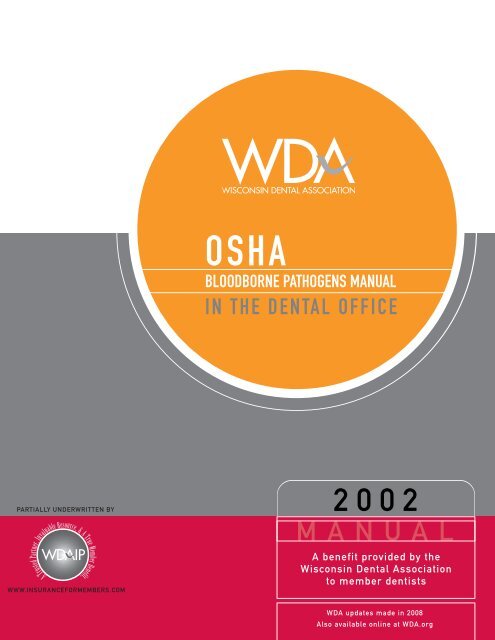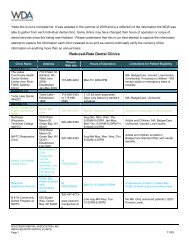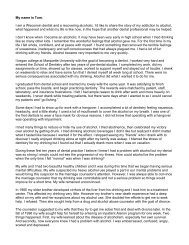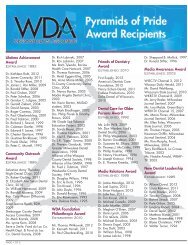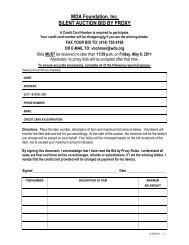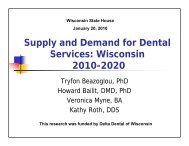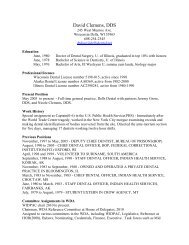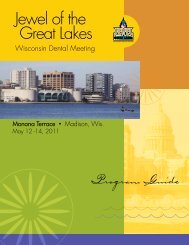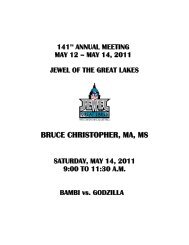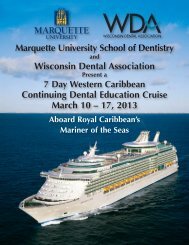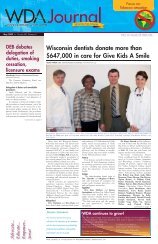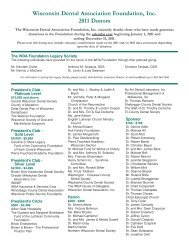Download the OSHA manual - Wisconsin Dental Association
Download the OSHA manual - Wisconsin Dental Association
Download the OSHA manual - Wisconsin Dental Association
You also want an ePaper? Increase the reach of your titles
YUMPU automatically turns print PDFs into web optimized ePapers that Google loves.
TABLE OF CONTENTSHEPATITIS B VACCINATION AND ANTIBODY TESTING . . . . . . . . . . . . . . . . . . . . . . . . . . . . . . . . . . . . . . . . . 22-23Hepatitis B Vaccine Declination Form . . . . . . . . . . . . . . . . . . . . . . . . . . . . . . . . . . . . . . . . . . . . . . . . . . . . . . . 24POST-EXPOSURE EVALUATION AND FOLLOW-UP . . . . . . . . . . . . . . . . . . . . . . . . . . . . . . . . . . . . . . . . . . . . . . 25-26Occupational Exposure Incident Report Form Sample . . . . . . . . . . . . . . . . . . . . . . . . . . . 27For Use in this <strong>Dental</strong> Office . . . . . 28COMMUNICATION OF HAZARDS TO EMPLOYEES AND TRAINING . . . . . . . . . . . . . . . . . . . . . . . . . . . . . 29Labels and Signs . . . . . . . . . . . . . . . . . . . . . . . . . . . . . . . . . . . . . . . . . . . . . . . . . . . . . . . . . . . . . . . . . . . . . . . . . . . . . . . . . 29Information and Training . . . . . . . . . . . . . . . . . . . . . . . . . . . . . . . . . . . . . . . . . . . . . . . . . . . . . . . . . . . . . . . . . . . . . . . . . 30-31<strong>OSHA</strong> Bloodborne Pathogens Standard Training Record . . . . . . . . . . . . . . . . . . . . . . . . . . . . . . . . . . . . . . . . . 32Sample . . . . . . . . . . . . . . . . . . . . . . . . . . . 32For Use in this <strong>Dental</strong> Office . . . . . 33RECORD KEEPING . . . . . . . . . . . . . . . . . . . . . . . . . . . . . . . . . . . . . . . . . . . . . . . . . . . . . . . . . . . . . . . . . . . . . . . . . . . . . . 34EVALUATION AND REVIEW OF EXPOSURE CONTROL PLAN . . . . . . . . . . . . . . . . . . . . . . . . . . . . . . . . . . . 35APPENDIX (Reference Materials) . . . . . . . . . . . . . . . . . . . . . . . . . . . . . . . . . . . . . . . . . . . . . . . . . . . . . . . . . . . . . . . . a1Employer Reference Pages . . . . . . . . . . . . . . . . . . . . . . . . . . . . . . . . . . . . . . . . . . . . . . . . . . . . . . . . . . . . . . . . . . a1-12Employer Liability . . . . . . . . . . . . . . . . . . . . . . . . . . . . . . . . . . . . . . . . . . . . . . . . . . . . . . . . . . . . . . . . . . . . . . . a1-3Employer Rights at <strong>the</strong> Time of an <strong>OSHA</strong> Inspection . . . . . . . . . . . . . . . . . . . . . . . . . . . . . . . . . . . . a4Employer — Frequently Asked Questions . . . . . . . . . . . . . . . . . . . . . . . . . . . . . . . . . . . . . . . . . . . . . . . a5Useful Definitions . . . . . . . . . . . . . . . . . . . . . . . . . . . . . . . . . . . . . . . . . . . . . . . . . . . . . . . . . . . . . . . . . . . . . . . . . . . a6Web Sites for Referential Documents/O<strong>the</strong>r Helpful Contacts . . . . . . . . . . . . . . . . . . . . . . . . . . . . . . . a7Needle Safety Amendments . . . . . . . . . . . . . . . . . . . . . . . . . . . . . . . . . . . . . . . . . . . . . . . . . . . . . . . . . . . . . . . . . a8-9State and Federal Poster Requirements . . . . . . . . . . . . . . . . . . . . . . . . . . . . . . . . . . . . . . . . . . . . . . . . . . . . . a10-12WDA WEB SITE . . . . . . . . . . . . . . . . . . . . . . . . . . . . . . . . . . . . . . . . . . . . . . . . . . . . . . . . . . . . . . . . . . . . . . . . . . . . . . . . . .MEMBERSHIP SERVICES SUMMARY . . . . . . . . . . . . . . . . . . . . . . . . . . . . . . . . . . . . . . . . . . . . . . . . . . . . . . . . . . .a13a14<strong>OSHA</strong> Bloodborne Pathogens Manual can be accessed from <strong>the</strong> WDA Web site, www.wda.orgWDA updates made in 2008<strong>OSHA</strong> EXPOSURE CONTROL PLAN…a member benefit from <strong>the</strong> WDAiii
WDA DISCLAIMERThis <strong>OSHA</strong> Exposure Control Plan has been developed by <strong>the</strong> <strong>Wisconsin</strong><strong>Dental</strong> <strong>Association</strong>, in conjunction with Dr. Elise Sampson (MarquetteUniversity School of Dentistry), and is provided for informationalpurposes only. It should not be construed or understood as legal adviceon any specific issue or issues. The contents of this publication are generalin nature and cannot be relied upon for guidance in specific situations.You (<strong>the</strong> employer) should consult with your attorney to determine howmatters discussed in this plan may relate to your practice or situation.THE WISCONSIN DENTAL ASSOCIATION, INC. MAKES NOREPRESENTATION OR WARRANTY, EITHER EXPRESSED ORIMPLIED, WITH RESPECT TO THIS PLAN AND DOES HEREBYEXPRESSLY DISCLAIM ANY AND ALL WARRANTIES AS TO THEACCURACY OF THE CONTENTS OF THIS MATERIAL, ITSAPPLICABILITY TO ANY SPECIFIC CIRCUMSTANCES ORSITUATION, OR ITS APPLICABILITY OR VALIDITY IN ANYPARTICULAR JURISDICTION. The <strong>Wisconsin</strong> <strong>Dental</strong> <strong>Association</strong>,Inc. expressly disclaims any and all:i) responsibility for opinion(s) expressed by <strong>the</strong> author and anyinaccuracies, errors or omissions contained in <strong>the</strong>se materials;ii) obligation to revise or update <strong>the</strong>se materials at anytime in<strong>the</strong> future.<strong>OSHA</strong> EXPOSURE CONTROL PLAN…a member benefit from <strong>the</strong> WDA 1
EXPOSURE CONTROL PLAN, PURPOSE AND ADMINISTRATIONPURPOSE(<strong>Dental</strong> Office/Practice/Facility Name)is committed to providing a safe and healthful work environment for our entire staff.In pursuit of this endeavor, <strong>the</strong> following Exposure Control Plan is provided to eliminateor minimize occupational exposures to bloodborne pathogens in accordance with<strong>OSHA</strong> Standard 29 CFR 1910.1030, “Occupational Exposure to Bloodborne Pathogens”.The Exposure Control Plan is a key document to assist this dental office/practice/facilityin implementing and ensuring compliance with The Standard, <strong>the</strong>reby protecting ouremployees.ADMINISTRATIONDirections: The spaces below are to be completed by ei<strong>the</strong>r <strong>the</strong> employeror assigned staff person.____________________ is in charge of <strong>the</strong> implementation of this Exposure Control Plan.________________________ will maintain, review, and update <strong>the</strong> Exposure Control Planat least annually, and whenever necessary to include new or modifiedtasks and procedures.________________________ will ensure that those employees who are determined to haveoccupational exposure to blood or o<strong>the</strong>r potentially infectious materialswill comply with <strong>the</strong> procedures and work practices outlined in thisExposure Control Plan.________________________ will maintain and provide all necessary personal protective equipment,engineering controls (e.g., sharps containers), labels, and red bags asrequired by <strong>the</strong> Standard.________________________ will ensure that adequate supplies of <strong>the</strong> aforementioned equipment areavailable in <strong>the</strong> appropriate sizes.________________________ will ensure that all medical actions required are performed and thatappropriate employee health and <strong>OSHA</strong> records are maintained.________________________ will conduct training, will maintain documentation of training and willprovide <strong>the</strong> written Exposure Control Plan available to employees.________________________ will provide <strong>the</strong> written Exposure Control Plan to <strong>OSHA</strong>,and NIOSH representatives.<strong>OSHA</strong> EXPOSURE CONTROL PLAN…a member benefit from <strong>the</strong> WDA 2
INSTRUCTIONS FOR EXPOSURE CONTROL PLAN USEPLEASE READ CAREFULLY!CHECKBOXESThe authors strongly recommend that <strong>the</strong> following individuals…THE EMPLOYER(S)The person(s) ultimately responsible for assuring full compliance of <strong>the</strong> requirements of <strong>the</strong>Bloodborne Pathogens Standards.AND THE ASSIGNED STAFF PERSON(S)The person(s) delegated to implement portions of this Exposure Control Plan.…read each statement very carefully, before placing a checkmark in <strong>the</strong> boxes provided. It is essentialthat you are certain <strong>the</strong> procedure indicated in each statement is being followed in your dentaloffice/practice/facility.TO ENSURE COMPLIANCE IT IS STRONGLY RECOMMENDED THAT YOUPROVIDE STATEMENTS IN THE SPACES GIVEN AND CHECK EACH BOXTHAT APPROPRIATELY DESCRIBES YOUR OFFICE'S PRACTICES.Please be honest and DO NOT check <strong>the</strong> boxes that do not reflect your office policies, proceduresand standards. It is imperative, however; that by evaluating <strong>the</strong> boxes left unchecked that yourdental office/practice/facility take steps to be able to check all boxes and ultimately come into fullcompliance with all portions of <strong>the</strong> plan.EXPOSURE CONTROL PLAN (ECP) SPACESThere are multiple spaces that must be filled in with <strong>the</strong> name(s) of <strong>the</strong> employer(s) and/or assignedstaff person(s). (These spaces must be filled in with <strong>the</strong> name(s) of <strong>the</strong> appropriate person(s) in youroffice/practice/facility.)ECP AVAILABILITY TO EMPLOYEESOnce reviewed by <strong>the</strong> employer(s) and assigned staff person(s) this Exposure Control Plan shall be madeavailable to employees in this dental office/practice/facility who are at risk of exposure to blood or o<strong>the</strong>rpotentially infectious materials.ECP FORMSAll forms are located within its corresponding section (e.g. Needlestick Safety and Prevention formis in <strong>the</strong> Needlestick Safety and Prevention section). Sample forms demonstrate <strong>the</strong> correct way tocomplete each form. Original forms are provided for <strong>the</strong> dental office/practice/facility to duplicate,complete and update when needed.APPENDIXContains materials that are intended to supplement <strong>the</strong> contents of this <strong>manual</strong>. These materials are notpart of <strong>the</strong> <strong>OSHA</strong> exposure control plan.The appendix is provided for additional information that mightassist in clarifying procedures, or which may provide additional informational resources, as well as offerdental specific recommendations. This material is very useful and should be read and utilized accordingly.<strong>OSHA</strong> EXPOSURE CONTROL PLAN…a member benefit from <strong>the</strong> WDA 3
EXPOSURE DETERMINATIONDEFINITION<strong>OSHA</strong> requires employers to perform an exposure determination toidentify which employees may incur occupational exposure to bloodand/or o<strong>the</strong>r potentially infectious materials. The exposure determinationis made without regard to <strong>the</strong> use of personal protective equipment.Employees are considered to be at risk for exposure even if <strong>the</strong>y wearpersonal protective equipment. An exposure determination has beendeveloped for this dental office/practice/facility by listing all jobclassifications in which all employees may be expected to incuroccupational exposure, regardless of frequency.EMPLOYER PAGEATTENTION<strong>OSHA</strong> EXPOSURE CONTROL PLAN…a member benefit from <strong>the</strong> WDA 4
EXPOSURE DETERMINATION FORM<strong>Dental</strong> Office/Practice/Facility Name:Address:Dr. Doe <strong>Dental</strong>000 Apple StreetAny Town, USA 12345Dr. John Doe and Dr. John SmithEmployer Name(s):must acknowledge <strong>the</strong>ir responsibility to provide all employees who perform taskswhich could potentially place <strong>the</strong>m at risk for occupational exposure to bloodand/or o<strong>the</strong>r potentially infectious materials with full protection as stated in <strong>the</strong><strong>OSHA</strong> Bloodborne Pathogens Standard 29 CFR part 1910.1030.FORM1sThis exposure determination has been made without regard to <strong>the</strong> use of personal protective equipment.Dentists<strong>Dental</strong> HygienistsLab Technicians/O<strong>the</strong>rReceptionistJOB CLASSIFICATIONList all job classifications in which employees haveoccupational exposure in this office/practice/facility<strong>Dental</strong> Assistants<strong>Dental</strong> Intern*List job classifications in which some, not all, employees,have occupational exposure in this office/practice/facilityTASKS AND PROCEDURES IN WHICH OCCUPATIONAL EXPOSURE WILL OCCUROperatory cleanup procedures including cleaningand processing instruments, disinfection of allcontaminated surfaces and replacement of paperand plastic drapes.These duties are performed byreceptionist when dental assistant is on vacation.SAMPLE* If this person is an unpaid student he/she is not covered by <strong>the</strong> OSH Act (<strong>OSHA</strong>). However, for liability purposes, it is wise to include <strong>the</strong>m in your program.<strong>OSHA</strong> EXPOSURE CONTROL PLAN…a member benefit from <strong>the</strong> WDA 5
EXPOSURE DETERMINATION FORMFor use in this dental office/practice/facility<strong>Dental</strong> Office/Practice/Facility Name:Address:Employer Name(s):must acknowledge <strong>the</strong>ir responsibility to provide all employees who perform taskswhich could potentially place <strong>the</strong>m at risk for occupational exposure to bloodand/or o<strong>the</strong>r potentially infectious materials with full protection as stated in <strong>the</strong><strong>OSHA</strong> Bloodborne Pathogens Standard 29 CFR part 1910.1030.This exposure determination has been made without regard to <strong>the</strong> use of personal protective equipment.FORM1List all job classifications in which employees haveoccupational exposure in this office/practice/facilityFORUSE INOFFICEList job classifications in which some, not all, employees,have occupational exposure in this office/practice/facilityJOB CLASSIFICATIONTASKS AND PROCEDURES IN WHICH OCCUPATIONAL EXPOSURE WILL OCCUR<strong>OSHA</strong> EXPOSURE CONTROL PLAN…a member benefit from <strong>the</strong> WDA 6
METHODS OF IMPLEMENTATION AND CONTROLUNIVERSAL PRECAUTIONS<strong>OSHA</strong> Definition…“Universal Precautions” is an approach to infection control…all human blood and certain human bodyfluids are treated as if known to be infectious for HIV, HBV, HCV and o<strong>the</strong>r bloodborne pathogens.In this <strong>Dental</strong> Office/Practice/Facility, since medical history and examination cannot reliablyidentify all patients with Hepatitis B, C, HIV infection and/or o<strong>the</strong>r bloodborne pathogens, bloodand body fluid precautions are consistently used for all patients and when handling contaminatedinstruments, equipment, appliances, waste (regulated and o<strong>the</strong>r) and laundry.EXPOSURE CONTROL PLANEMPLOYEE RIGHTSIn this <strong>Dental</strong> Office/Practice/Facility: Employees covered by <strong>the</strong> Bloodborne Pathogens Standard receive an explanation of this ExposureControl Plan during <strong>the</strong>ir initial training session.This Exposure Control Plan is reviewed in employee’s annual training. Employees have an opportunity to review this plan at any time during <strong>the</strong>ir work shifts by contacting(Name of assigned staff person) If requested, I/we, <strong>the</strong> employer, will provide an employee with a written copy of this Exposure ControlPlan free of charge and within 15 days of <strong>the</strong> request.EMPLOYER RESPONSIBILITIESDirections: The spaces below are to be completed by ei<strong>the</strong>r <strong>the</strong> employeror assigned staff person.EMPLOYER PAGEATTENTION ________________________ will review and update <strong>the</strong> Exposure Control Plan on annualbasis. Annual update of documentation will also include anassessment of technology changes that can reduce exposures. ________________________ will review and update <strong>the</strong> Exposure Control Plan more frequently,if necessary, to reflect any new or modified tasks and procedures. ________________________ will review and update <strong>the</strong> Exposure Control Plan to reflect new orrevised employee positions with occupational exposure.<strong>OSHA</strong> EXPOSURE CONTROL PLAN…a member benefit from <strong>the</strong> WDA 7
ENGINEERING AND WORK PRACTICE CONTROLSIn this <strong>Dental</strong> Office/Practice/Facility:Engineering and work practice controls are utilized to eliminate or minimize exposure of employeesas follows:A. SHARPS CONTAINERS Sharps containers are closeable, labeled with <strong>the</strong> BIOHAZARD symbol (see page 29), punctureresistant, leak proof on <strong>the</strong> sides and bottom and designed so that employees cannot reach into <strong>the</strong>opening and be injured by <strong>the</strong> contents.Directions: Please complete spaces below with <strong>the</strong> name of <strong>the</strong> appropriate assignedstaff person. Please be sure <strong>the</strong> name corresponds with <strong>the</strong> statement. ______________________________ will ensure that sharps containers are inspected according to <strong>the</strong>schedule listed below.They are inspected: daily weekly O<strong>the</strong>r:(Please specify) ______________________________ will ensure that when filled to <strong>the</strong> required safety level, <strong>the</strong> sharpscontainers are closed, made ready for pick-up, transported ormailed to an appropriate storage site and replaced.Storage site: room #__________________________________REGULATED WASTE SERVICEName of Waste Service:Address:Phone:Pick up Schedule: ___/____/___ ___/____/___ ___/___/____ ___/___/______/____/___ ___/____/___ ___/___/___ ___/___/___B. OTHER ENGINEERING CONTROLSWhenever possible, procedures are conducted in a manner which minimizes splashing,spraying, splattering and generation of droplets of blood or o<strong>the</strong>r potential infectious materialsby appropriate use of: Rubber dams High volume suction Saliva ejectors O<strong>the</strong>r:(Please Specify)<strong>OSHA</strong> EXPOSURE CONTROL PLAN…a member benefit from <strong>the</strong> WDA 8
ENGINEERING AND WORK PRACTICE CONTROLS CONTINUEDIn this <strong>Dental</strong> Office/Practice/Facility:C. PROGRAM TO SELECT AND EVALUATE SAFER MEDICAL DEVICESThe revision of <strong>OSHA</strong> Bloodborne Pathogens Standard “Needlestick Safety and Prevention Act”(PL 106-430) requires employers to identify and make use of effective and safer medical devices for dentaloffices (this largely refers to <strong>the</strong> review of safer needles or injection devices used in providing dental care)with <strong>the</strong> intention of reducing or eliminating worker exposure.Several sources of information are available for identifying and evaluating <strong>the</strong> appropriateness of newdevices with engineering safety features. These include, but are not limited to, searching <strong>the</strong> Internet,reviewing dental and o<strong>the</strong>r literature and reviewing new products at professional meetings.This <strong>Dental</strong> Office/Practice/Facility solicits input from employees on safety devices as follows: Employees are actively encouraged to solicit and review current information on new safety devicesas it becomes available.Employees meet: quarterly annually as per office calendarto review sharps (needles etc..) and/or sharp instruments with engineered sharps injury protection thathave become available during this time period. If appropriate, recommendations will be made to <strong>the</strong>employer as to <strong>the</strong> selection of <strong>the</strong> alternative devices.Please note:• Employees are required to meet at least annually.• Small offices may discuss and make recommendations on a moreinformal basis.• A dental office should only consider needlesafe devices that have been firsttested and approved by both <strong>the</strong> Food and Drug Administration (FDA) and<strong>the</strong> American <strong>Dental</strong> <strong>Association</strong> (ADA). FDA and ADA approved devicescan <strong>the</strong>n be fur<strong>the</strong>r evaluated by dentists and staff for potential use withinindividual offices. (Please see page a8 for a list of suggested criteria fordental offices to use when evaluating a needlesafe device.)This exposure control plan is reviewed annually to reflect new instruments and/or equipment now inuse in this dental office/practice/facility as <strong>the</strong> result of <strong>the</strong> Needlestick Safety and Prevention Act. Solicitation of input from employees is documented in this exposure control plan by completing <strong>the</strong>Needlestick Safety and Prevention Act Form (see page 10-11).<strong>OSHA</strong> EXPOSURE CONTROL PLAN…a member benefit from <strong>the</strong> WDA 9
NEEDLESTICK SAFETY AND PREVENTION ACT FORMListed below are <strong>the</strong> employees involved in selecting, disseminatingand collecting data relative to <strong>the</strong> following new safety devices.EMPLOYEE NAMEJane DoeJohn SmithPOSITION/TITLE<strong>Dental</strong> Hygienist<strong>Dental</strong> AssistantFORMDescribe <strong>the</strong> process whereby input is requested:Annual meetings in which employees discuss alternative safety deviceswith <strong>the</strong> employer.Meeting date(s): ___________ 4/2006 ___________ 4/2007 ___________ 4/2008 ___________ ___________Minutes of Meeting(s)xAttached to this form O<strong>the</strong>r:(Please Specify)Copies of documents used to request employee participationx Attached to this form O<strong>the</strong>r:(Please Specify)Records of responses received from employees to <strong>the</strong> employer(s)(Such as reports evaluating effectiveness of a safer device)x Attached to this form O<strong>the</strong>r:(Please Specify)2sSAMPLE<strong>OSHA</strong> EXPOSURE CONTROL PLAN…a member benefit from <strong>the</strong> WDA 10
NEEDLESTICK SAFETY AND PREVENTION ACT FORMFor use in this dental office/practice/facilityListed below are <strong>the</strong> employees involved in selecting, disseminating,and collecting data relative to <strong>the</strong> following new safety devices.EMPLOYEE NAMEPOSITION/TITLEFORMDescribe <strong>the</strong> process whereby input is requested:2Meeting date(s): ___________ ___________ ___________ ___________ ___________Minutes of Meeting(s) Attached to this form O<strong>the</strong>r:(Please Specify)Copies of documents used to request employee participation Attached to this form O<strong>the</strong>r:(Please Specify)Records of responses received from employees to <strong>the</strong> employer(s)(Such as reports evaluating effectiveness of a safer device) Attached to this form O<strong>the</strong>r:(Please Specify)FORUSE INOFFICEFORUSE INOFFICEReminder: Don’t forget to attach <strong>the</strong> actual documents that have been indicated on <strong>the</strong> checkboxes.<strong>OSHA</strong> EXPOSURE CONTROL PLAN…a member benefit from <strong>the</strong> WDA 11
ENGINEERING AND WORK PRACTICE CONTROLS CONTINUEDIn this <strong>Dental</strong> Office/Practice/Facility:D. WASHING FACILITIES Washing facilities are available and readily accessible to all employees. Hands are washed thoroughly with warm water and <strong>the</strong> anti-microbial soap solution provided for thispurpose immediately after removal of gloves. O<strong>the</strong>r skin areas are washed immediately or as soon as feasible after being contaminated with bloodor o<strong>the</strong>r potentially infectious materials.E. DISPOSABLE SHARPSRecapping Needles-Rationale and Procedure:In dentistry, administering incremental doses of anes<strong>the</strong>tic to <strong>the</strong> same patient is often necessaryand local anes<strong>the</strong>tic syringes are reusable when used on <strong>the</strong> same patient during a single dentalappointment. It is necessary, <strong>the</strong>refore, to recap needles between use and to remove needles from<strong>the</strong> syringe after of each patient’s treatment.Handling and disposal of needles without strict compliance with <strong>the</strong> followingprotocol can lead to serious exposure to blood and o<strong>the</strong>r potentially infectious materials. Employees have been trained to perform <strong>the</strong>se procedures safely and in accordance with <strong>OSHA</strong>Bloodborne Pathogens Standard. Contaminated needles are uncoupled from syringe and immediately disposed of in <strong>the</strong> sharpscontainers provided for this purpose. Sharps containers are located as close as possible to <strong>the</strong> site of use. Contaminated needles are never bent, sheared or purposely broken.Needle recapping is performed: by <strong>the</strong> one-handed scoop methodOR by using mechanical devicesOR O<strong>the</strong>r:(Please specify)<strong>OSHA</strong> EXPOSURE CONTROL PLAN…a member benefit from <strong>the</strong> WDA 12
ENGINEERING AND WORK PRACTICE CONTROLS CONTINUEDIn this <strong>Dental</strong> Office/Practice/Facility:F. OTHER CONTAMINATED DISPOSABLE SHARPSContaminated disposable sharps such as scalpel blades, suture needles, broken instruments,broken glass, orthodontic wires and anes<strong>the</strong>tic carpules (which may cause injury and <strong>the</strong>reforeexposure to blood if broken) are handled as follows: Broken carpules (scalpel blades, suture needles, broken instruments, broken glass, orthodonticwires and anes<strong>the</strong>tic carpules) are picked up with forceps or brush and pan and placed immediatelyin <strong>the</strong> sharps container. O<strong>the</strong>r:(Please specify)G. REUSABLE SHARPSMany reusable dental instruments and appliances used in dentistry are sharp and, if handledimproperly, can cause injury and exposure to blood and o<strong>the</strong>r potentially infectious materials.To avoid potential injury when handling <strong>the</strong>se instruments and appliances <strong>the</strong>se proceduresare followed: During treatment that requires <strong>the</strong> use of reusable sharps (e.g., explorers, excavators, endonditcinstruments), instruments are passed to <strong>the</strong> assistant/operator in a firm and deliberate manner. Work surfaces are organized to minimize accidental injury with sharps. Sharp instruments are within <strong>the</strong> full vision of <strong>the</strong> individual who is reaching for <strong>the</strong>m. After patient treatment and during clean-up, contaminated instruments are always handled withheavy-duty gloves. Instruments are removed from <strong>the</strong> ultrasonic cleaner by lifting <strong>the</strong>m from <strong>the</strong> basket. O<strong>the</strong>r:(Please specify)<strong>OSHA</strong> EXPOSURE CONTROL PLAN…a member benefit from <strong>the</strong> WDA 13
ENGINEERING AND WORK PRACTICE CONTROLS CONTINUEDIn this <strong>Dental</strong> Office/Practice/Facility:H. WORK AREA RESTRICTIONSEating, drinking, applying makeup or lip balm, smoking or handling contact lenses isprohibited in all areas where <strong>the</strong>re is potential for contamination with blood or o<strong>the</strong>r potentiallyinfectious materials.The above activities may not be conducted in <strong>the</strong> following areas:For example: Patient Treatment Rooms Laboratories Sterilizing Room O<strong>the</strong>r:(Please specify)The activities listed above (e.g., eating, drinking) are allowed in <strong>the</strong> following areas of this dentaloffice/practice/facility:______________________ ______________________ _____________________________________________ ______________________ _______________________ Food and beverages are not kept in refrigerators, freezers, shelves, cabinets or on counter tops or benchtops where blood or o<strong>the</strong>r potentially infectious materials are present.Food and beverages may be safely stored in <strong>the</strong> following areas in this dental office/practice/facility:______________________ ______________________ _____________________________________________ ______________________ _______________________<strong>OSHA</strong> EXPOSURE CONTROL PLAN…a member benefit from <strong>the</strong> WDA 14
ENGINEERING AND WORK PRACTICE CONTROLS CONTINUEDIn this <strong>Dental</strong> Office/Practice/Facility:I. IMPRESSIONS/APPLIANCES/EQUIPMENT ETC. Universal precautions are used at all times whenever handling anything contaminated with bloodor o<strong>the</strong>r potentially infectious materials. It is not necessary <strong>the</strong>refore to label impressions and/orappliances, etc. when handling and transporting <strong>the</strong>m within this dental office/practice/facility. All materials (impressions, appliances, etc.) are decontaminated (see below) before entering <strong>the</strong>office in-house laboratory. All materials (impressions, appliances, etc.) are decontaminated (see below) before packaging forshipping to an outside laboratory.Decontamination method used: 1) Rinse away saliva and debris with running waterAND 2) Immerse inOR 2) Spray with(Name of <strong>the</strong> disinfectant used and immersion time as per package instructions)(Name of <strong>the</strong> disinfectant used and contact time as per package instructions) Equipment, which has been contaminated with blood or o<strong>the</strong>r potentially infectious materials, isdecontaminated before servicing or shipping. Contaminated equipment, which cannot be decontaminated before servicing or shipping, will beidentified with a biohazard-warning label. (See page 29)<strong>OSHA</strong> EXPOSURE CONTROL PLAN…a member benefit from <strong>the</strong> WDA 15
PERSONAL PROTECTIVE EQUIPMENTThe personal protective equipment used in this dental office/practice/facility is consideredappropriate because it does not permit blood or o<strong>the</strong>r potentially infectious materials to passthrough or reach employees’ work or street clothing, skin, eyes, mouth or o<strong>the</strong>r mucous membranesunder normal conditions of use and for <strong>the</strong> duration of time which <strong>the</strong> protective equipment is used.Directions: The spaces below are to be completed with <strong>the</strong> employer’s name. ________________________ shall ensure that employees use personal protective equipmentappropriate to <strong>the</strong> task being performed.(Unless <strong>the</strong> employer shows that <strong>the</strong> employee temporarily and brieflydeclined to use Personal Protective Equipment when under rare andextraordinary circumstances, it was <strong>the</strong> employee’s professional judgmentthat in <strong>the</strong> specific instance its use would have prevented <strong>the</strong> delivery ofhealth care and public safety services and posed an increased hazard to<strong>the</strong> safety of <strong>the</strong> worker or co-worker. When <strong>the</strong> employee makes thisjudgment, <strong>the</strong> circumstances shall be investigated and documented inorder to determine whe<strong>the</strong>r changes can be instituted to prevent suchoccurrences in <strong>the</strong> future.) ________________________ shall ensure that appropriate personal protective equipment is issuedwithout cost to employees. ________________________ shall ensure that employees remove personal protective equipmentafter it becomes contaminated in such a way as to avoid skin contactwith <strong>the</strong> outside surface. ________________________ shall ensure employees remove personal protective equipment beforeleaving <strong>the</strong> work area.EMPLOYER PAGEATTENTIONDirections: The spaces below are for <strong>the</strong> employer’s or assigned staff person’s name. ________________________ shall ensure that suitable personal protective equipment is availablein suitable sizes. ________________________ shall ensure that personal protective equipment is readily accessibleat <strong>the</strong> work site. ________________________ shall ensure that hypoallergenic gloves, glove liners, powder-freegloves or o<strong>the</strong>r similar alternatives are readily accessible to thoseemployees who are allergic to <strong>the</strong> gloves normally provided.<strong>OSHA</strong> EXPOSURE CONTROL PLAN…a member benefit from <strong>the</strong> WDA 16
PERSONAL PROTECTIVE EQUIPMENT CONTINUEDIn this <strong>Dental</strong> Office/Practice/Facility:A. GLOVES SINGLE-USE GLOVES are worn at all times where it is reasonably anticipated that employees willhave hand contact with blood or o<strong>the</strong>r potentially infectious materials, non-intact skin and/or mucousmembranes; when performing vascular access procedures and when laundering or touchingcontaminated items or surfaces. These gloves are replaced as soon as practical when <strong>the</strong>y becomecontaminated or as soon as <strong>the</strong>ir ability to function as a barrier is compromised. These gloves are notwashed or decontaminated for reuse. REUSABLE GLOVES (heavy duty, utility gloves) are worn when cleaning and decontaminatingpatient treatment areas; transporting and cleaning contaminated instruments after patient treatmentis completed. REUSABLE GLOVES are used for cleaning and decontaminating lab areas. REUSABLE GLOVES are decontaminated for re-use provided <strong>the</strong> integrity of <strong>the</strong> glove is notcompromised. Utility gloves are discarded if <strong>the</strong>y are cracked, peeling, torn, punctured or exhibit o<strong>the</strong>rsigns of deterioration or when <strong>the</strong>ir ability to function as a barrier is compromised ALL GLOVES are provided for use in <strong>the</strong> appropriate size for <strong>the</strong> user. All employees with allergies to <strong>the</strong> glove material or powder inside <strong>the</strong> glove are provided withpowder-free and/or non-allergenic gloves and/or glove liners.B. EYE AND FACE PROTECTION Masks, in combination with eye protection devices such as goggles or glasses with solid side shields orchin-length face shields, are required to be worn whenever splashes, spray, splatter or droplets of bloodor o<strong>the</strong>r potentially infectious materials may be anticipated.C. PERSONAL PROTECTIVE CLOTHING Protective clothing is worn whenever it is reasonably anticipated employees’ work clo<strong>the</strong>s,street clo<strong>the</strong>s, undergarments or skin may become contaminated with blood or o<strong>the</strong>r potentiallyinfectious materials.<strong>OSHA</strong> EXPOSURE CONTROL PLAN…a member benefit from <strong>the</strong> WDA 17
PERSONAL PROTECTIVE EQUIPMENT CONTINUEDIn this <strong>Dental</strong> Office/Practice/Facility:D. RESUSCITATION MASKS OR DEVICES Mouthpieces, resuscitation bags, pocket masks and/or ventilation bags are readily available foremergency situation and/or CPR training.Location of resuscitation device(s): ________________________ _______________________E. OTHER PROTECTIVE CLOTHING/DEVICES Additional protective wear is worn, as appropriate, for <strong>the</strong> task being performed. Situations whichwould require such protection (e.g., gloves, masks) are as follows:______________________ ______________________ _______________________F. DISPOSAL, STORAGE, CLEANING AND LAUNDERING Personal protective equipment (e.g., gloves, masks) is disposed of as follows:______________________ ______________________ _______________________(List appropriate containers for disposal) Reusable personal protective equipment (e.g., goggles, face shields, resuscitation masks or devices) arecleaned as follows: Gowns/lab coats are stored before laundering in appropriately labeled/color-coded containers andlaundered by: Gowns/lab coats are laundered at NO COST to employees. All repairs and replacements of personal protective equipment are made atNO COST to employees (e.g., gloves, masks).<strong>OSHA</strong> EXPOSURE CONTROL PLAN…a member benefit from <strong>the</strong> WDA 18
HOUSEKEEPINGIn this <strong>Dental</strong> Office/Practice/Facility:A. GENERAL HOUSEKEEPINGThis dental office/practice facility is cleaned and decontaminated according to a regular schedule: Daily O<strong>the</strong>r:(Please specify)B. CLINICAL AREA DECONTAMINATION All surfaces/equipment contaminated with blood or o<strong>the</strong>r potentially infectious materials aredecontaminated by utilizing <strong>the</strong> following EPA registered, tuberculocidal disinfectant(s):______________________ ______________________ _______________________(Name of disinfectant(s)) A spray/wipe/spray method of decontamination is used. Surfaces are left wet for ______ minutes(as prescribed by <strong>the</strong> manufacturer). All contaminated work surfaces are decontaminated after completion of patient treatment proceduresand immediately or as soon as feasible after any spill of blood or o<strong>the</strong>r potentially infectious materials,and also at <strong>the</strong> end of <strong>the</strong> work shift if <strong>the</strong> surface has become contaminated since <strong>the</strong> last cleaning. Protective covers are used to shield equipment or surfaces which, because of location or design, aredifficult to clean and disinfect adequately. All bins, pails, cans and similar receptacles are inspected and decontaminated on a regularlyscheduled basis.<strong>OSHA</strong> EXPOSURE CONTROL PLAN…a member benefit from <strong>the</strong> WDA 19
HOUSEKEEPING CONTINUEDC. IN-HOUSE LAUNDRY PROCEDURES Universal precautions are utilized in <strong>the</strong> handling of all contaminated laundry. No labelingor color-coding of individual pieces of contaminated laundry is required in <strong>the</strong> dental office(although appropriate labeling of <strong>the</strong> bags and/or containers that <strong>the</strong> contaminated laundryis stored in is recommended). Employees are educated to recognize <strong>the</strong> hazards associated with <strong>the</strong> handling of contaminated laundry. Employees handling laundry contaminated with blood or o<strong>the</strong>r potentially infectious materials occursas little as possible. Laundry not labeled is placed in appropriately labeled bags and/or containers.Circle one: Biohazard labeled OR Color-coded red bag When laundry is wet, it is stored in a leak proof container.Please note: If this facility ships contaminated laundry off-site to ano<strong>the</strong>rfacility <strong>the</strong> scope of work contract with <strong>the</strong> launderer will be required toutilize <strong>the</strong> equivalent of universal precautions.<strong>OSHA</strong> EXPOSURE CONTROL PLAN…a member benefit from <strong>the</strong> WDA 20
REGULATED WASTEDEFINITION OF REGULATED WASTE:Liquid or semi-liquid blood or o<strong>the</strong>r potentially infectious materials• Contaminated items that would release blood or o<strong>the</strong>r potentially infectious materials in aliquid or semi-liquid state, if compressed• Items that are caked with dried blood or o<strong>the</strong>r potentially infectious materials and are capableof releasing <strong>the</strong>se materials during handlingContaminated sharps• Pathological and microbiological wastes containing blood or o<strong>the</strong>r potentiallyinfectious materialsIn this <strong>Dental</strong> Office/Practice/Facility: Regulated waste is placed in containers which are closeable, constructed to contain all contentsand prevent leakage. Regulated waste is placed in appropriately identified containers:Circle one: Biohazard Labels OR Red Containers Regulated waste containers are closed prior to removal to prevent spillage or protrusionof contents during handling.REGULATED WASTE SERVICE:NameAddressPhone Number<strong>OSHA</strong> EXPOSURE CONTROL PLAN…a member benefit from <strong>the</strong> WDA 21
HEPATITIS B VACCINATION AND ANTIBODY TESTINGDirections: The spaces below are to be completed by <strong>the</strong> employer. ________________________ makes available <strong>the</strong> Hepatitis B vaccine series to all coveredemployees (identified in this Exposure Control Plan) who are at riskof occupational exposure, at no cost to <strong>the</strong>m after training and within10 days of initial employment.Please note: Vaccination is encouraged unless (1) documentation exists that<strong>the</strong> employee has previously received <strong>the</strong> vaccine series, (2) antibody testingreveals that <strong>the</strong> employee has previously received <strong>the</strong> series or (3) medicalevaluation shows that vaccination is contraindicated. ________________________ ensures that one or two months following <strong>the</strong> Hepatitis B vaccinationseries all employees who are at risk of occupational exposure will betested for HBV surface antibody. ________________________ ensures that vaccination is performed by or under <strong>the</strong> supervisionof a licensed physician, or by or under <strong>the</strong> supervision of ano<strong>the</strong>rlicensed health care professional.Name/address of licensed physician or licensed healthcare professional ________________________ has determined that all laboratory testing is conducted by anaccredited laboratory. Evidence of such accreditation is on file.Please note: It is <strong>the</strong> employer’s responsibility to assure that all laboratorytests be conducted by an accredited laboratory. Employer documentation(e.g., certification to verify this accreditation, such as CDC or College ofAmerican Pathologists or equivalent state agency, which participates in arecognized quality assurance program) is required. ________________________ ensures that employees who decline <strong>the</strong> Hepatitis B vaccination havesigned <strong>the</strong> <strong>OSHA</strong> required waiver indicating <strong>the</strong>ir refusal found onpage 24 of this Exposure Control Plan. ________________________ ensures that if an employee initially declines <strong>the</strong> Hepatitis Bvaccination, but at a later date, while still covered under <strong>the</strong>Bloodborne Pathogens Standard, decides to accept <strong>the</strong>vaccination, <strong>the</strong> vaccination shall <strong>the</strong>n be made available at no costto <strong>the</strong> employee.EMPLOYER PAGEATTENTION<strong>OSHA</strong> EXPOSURE CONTROL PLAN…a member benefit from <strong>the</strong> WDA 22
HEPATITIS B VACCINATION AND ANTIBODY TESTING CONTINUED ________________________ will file a statement (from <strong>the</strong> health care professional responsible forvaccination) which states whe<strong>the</strong>r <strong>the</strong> employee can or cannot bevaccinated for whatever reason and that, where appropriate, <strong>the</strong>vaccine has been administered. This is called <strong>the</strong> “HealthcareProfessional’s Written Opinion”. ________________________ will assure that <strong>the</strong> vaccination program is instituted and performed.Directions: The space below is to be filled in with <strong>the</strong> name of <strong>the</strong> person conducting <strong>the</strong> training. ________________________ provides training to employees on Hepatitis B vaccinations,addressing safety, benefits, efficacy, methods of administration andavailability.For more information on training requirements see pages 30-33 in this Exposure Control Plan.EMPLOYER PAGEATTENTION<strong>OSHA</strong> EXPOSURE CONTROL PLAN…a member benefit from <strong>the</strong> WDA 23
HEPATITIS B VACCINATION DECLINATION FORM MANDATORYFor use in this dental office/practice/facilityI understand that, due to my occupational exposure to blood or o<strong>the</strong>rpotentially infectious materials, I may be at risk of acquiring Hepatitis Bvirus (HBV) infection. I have been given <strong>the</strong> opportunity to bevaccinated with Hepatitis B vaccine, at no charge to myself. However,I decline Hepatitis B vaccination at this time. I understand that bydeclining this vaccine, I continue to be at risk of acquiring Hepatitis B,a serious disease. If in <strong>the</strong> future I continue to have occupational exposureto blood or o<strong>the</strong>r potentially infectious materials and I want to bevaccinated with Hepatitis B vaccine, I can receive <strong>the</strong> vaccination seriesat no charge to me.Employee signatureDate<strong>OSHA</strong> EXPOSURE CONTROL PLAN…a member benefit from <strong>the</strong> WDA 24
POST-EXPOSURE EVALUATION AND FOLLOW-UPFor use in this dental office/practice/facilityIn this <strong>Dental</strong> Office/Practice/Facility: When an employee receives an occupational exposure to blood or o<strong>the</strong>r potentially infectiousmaterial, first aid (e.g., clean <strong>the</strong> wound, flush <strong>the</strong> eyes or o<strong>the</strong>r mucous membrane) is administered assoon as feasible. All exposure incidents that occur are reported, investigated and documented.When <strong>the</strong> employee incurs an exposure, it is reported to:(Name of assigned staff person or employer)(Name of assigned staff person or employer) Following a report of an exposure incident, <strong>the</strong> exposed employee will immediately, or as soon aspossible (within 24 hours) be referred to <strong>the</strong> appropriate contracted health care provider for follow up.(Name, phone number, address of contracted health care provider)THE ABOVE STATED CONTRACTED HEALTH CARE PROVIDER will ensure that <strong>the</strong> exposedemployee will immediately, or as soon as possible, receive a confidential medical evaluation and followup including all of <strong>the</strong> following elements:Documentation of <strong>the</strong> routes of exposure and how <strong>the</strong> exposure incident occurred• Identification and documentation of <strong>the</strong> source individual, unless it can be established thatidentification is infeasible or prohibited by state or local law• The source individual’s blood shall be tested as soon as feasible and after consent is obtained inorder to determine Hepatitis B virus (HBV), Hepatitis C virus (HCV) and HumanImmunodeficiency Virus (HIV) infectivity• If <strong>the</strong> source individual is already known to be HBV, HCV and/or HIV positive, fur<strong>the</strong>r testingneed not be performed• The health care provider must assure that <strong>the</strong> exposed employee is provided with <strong>the</strong> sourceindividual’s test results while complying with all laws protecting confidentiality of <strong>the</strong> source andexposed individuals<strong>OSHA</strong> EXPOSURE CONTROL PLAN…a member benefit from <strong>the</strong> WDA 25
POST-EXPOSURE EVALUATION AND FOLLOW-UP CONTINUED• If source patient consent is not obtained:(Name, address of contracted health care provider/facility)shall establish that required consent cannot be obtained.Please note: Involuntary testing is limited by law and <strong>the</strong> conditions underwhich this can be performed are prescribed in Chapter 252.15 of <strong>the</strong><strong>Wisconsin</strong> Statutes. A copy of this regulation can be obtained by visiting <strong>the</strong>Division of Public Health web site (http://dhs.wisconsin.gov) or contacting<strong>the</strong> WDA — see appendix for contact information.• After obtaining consent, <strong>the</strong> exposed employee’s blood will be drawn and tested for HBV, HCVand HIV serological status.• If <strong>the</strong> employee does not give consent to test for baseline HIV during collection of blood, <strong>the</strong>baseline blood sample may be preserved for at least 90 days. If <strong>the</strong> exposed employee elects tohave this baseline sample tested during this waiting period, <strong>the</strong> test should be performed as soonas feasible. Following a report of an exposure incident, <strong>the</strong> employer will ensure that <strong>the</strong> health careprovider responsible for <strong>the</strong> employee’s post-exposure follow-up is provided with <strong>the</strong>following documentation:1) copy of <strong>the</strong> <strong>OSHA</strong> Bloodborne Pathogens Standard 29CFR 1910.10302) A copy of <strong>the</strong> Occupational Exposure Incident Report (see page 28 of this Exposure Control Plan)which includes <strong>the</strong> following:A written description of <strong>the</strong> employee’s job duties relevant to <strong>the</strong> exposure incidentRoute(s) of exposureCircumstances of <strong>the</strong> exposureIf possible, results of <strong>the</strong> source individual’s blood test• All medical records relevant to <strong>the</strong> appropriate treatment of <strong>the</strong> employee, includingvaccination status Following a report of an exposure incident, <strong>the</strong> employer will obtain and provide <strong>the</strong> employee with acopy of <strong>the</strong> evaluating Healthcare Professional’s Written Opinion within 15 days of <strong>the</strong> completion of<strong>the</strong> post-exposure evaluation and follow-up. This document includes <strong>the</strong> following:• Whe<strong>the</strong>r Hepatitis B vaccine is indicated in this case and if this person has received suchvaccinationstatement that <strong>the</strong> employee has been informed of <strong>the</strong> results of <strong>the</strong> post-exposure evaluation• A statement that <strong>the</strong> employee has been told about any medical conditions resulting fromexposure to blood or o<strong>the</strong>r potentially infectious materials which required evaluation ortreatment; all o<strong>the</strong>r findings or diagnoses shall not be included in <strong>the</strong> written reportPlease note: Timely reporting and follow-up of an exposure incident isessential so that chemical prophylaxis, if appropriate, can be administered in<strong>the</strong> most effective manner (within two hours if source patient is HIV carrier,o<strong>the</strong>rwise within 24 hours).<strong>OSHA</strong> EXPOSURE CONTROL PLAN…a member benefit from <strong>the</strong> WDA 26
OCCUPATIONAL EXPOSURE INCIDENT REPORTA SIGNIFICANT EXPOSURE OCCURS:1) Following percutaneous exposure (i.e., penetration of dental health care worker’s skin by a needle, a scalpelblade or o<strong>the</strong>r sharp object contaminated with a patient’s blood or o<strong>the</strong>r potentially infectious materials).2) Following contact between dental health care worker’s oral or nasal mucous membrane, cornea ornon-intact skin and patient blood, saliva or o<strong>the</strong>r potentially infectious materials (i.e., a splash ofpatient blood, saliva or o<strong>the</strong>r potentially infectious materials into <strong>the</strong> mouth, nose or eye of <strong>the</strong> dentalhealth care worker or direct contact of patient blood saliva or o<strong>the</strong>r potentially infectious material withan abrasion, cut or o<strong>the</strong>r opening in <strong>the</strong> skin of <strong>the</strong> dental health care worker).EMPLOYEE INFORMATIONExposed employee’s name:Jane DoeFORMPhone:Position:(414) 123-4567<strong>Dental</strong> Hygienist3sDate of exposure:Date of HBV Vaccination:Date of Anti HBs test:Date of last tetanus toxoid Vaccination:INCIDENT DESCRIPTION: (What occurred and where did it happen? Describe <strong>the</strong>exposure and whe<strong>the</strong>r this is a percutaneous, mucous membrane or corneal exposureas described above. What body part was affected?)Needle stick, left thumb, while administering injectionSource patient antibody status (if known):SOURCE PATIENT INFORMATIONSource Patient HBsAg status: Positive x NegativeHIV antibody status: Positive x NegativeSource Patient HCV antibody status: Positive x NegativeI, ____________________________ Jane Doe understand <strong>the</strong> significance of my exposure, as described above,I have been offered medical evaluation and treatment for <strong>the</strong> exposure but have decided, for personalreasons, not to have any such treatment.Dr. John Doe(Employer’s signature)00/00/000000/00/000000/00/000000/00/0000Jane Doe(Employee’s signature)SAMPLEThis document is CONFIDENTIAL and must be maintained by <strong>the</strong> employer for <strong>the</strong> length of employment plus 30 years.<strong>OSHA</strong> EXPOSURE CONTROL PLAN…a member benefit from <strong>the</strong> WDA 27
OCCUPATIONAL EXPOSURE INCIDENT REPORTFor use in this dental office/practice/facilityA SIGNIFICANT EXPOSURE OCCURS:1) Following percutaneous exposure (i.e., penetration of dental health care worker’s skin by a needle, a scalpelblade or o<strong>the</strong>r sharp object contaminated with a patient’s blood or o<strong>the</strong>r potentially infectious materials).2) Following contact between dental health care worker’s oral or nasal mucous membrane, cornea ornon-intact skin and patient blood, saliva or o<strong>the</strong>r potentially infectious materials (i.e., a splash ofpatient blood, saliva or o<strong>the</strong>r potentially infectious materials into <strong>the</strong> mouth, nose or eye of <strong>the</strong> dentalhealth care worker or direct contact of patient blood saliva or o<strong>the</strong>r potentially infectious material withan abrasion, cut or o<strong>the</strong>r opening in <strong>the</strong> skin of <strong>the</strong> dental health care worker).EMPLOYEE INFORMATIONExposed employee’s name:Phone:Position:FORM3Date of exposure:Date of HBV Vaccination:Date of Anti HBs test:FORUSE INOFFICEDate of last tetanus toxoid Vaccination:INCIDENT DESCRIPTION: (What occurred and where did it happen? Describe <strong>the</strong>exposure and whe<strong>the</strong>r this is a percutaneous, mucous membrane or corneal exposureas described above. What body part was affected?)Source patient antibody status (if known):SOURCE PATIENT INFORMATIONSource Patient HBsAg status: Positive NegativeHIV antibody status: Positive NegativeSource Patient HCV antibody status: Positive NegativeI, ____________________________ understand <strong>the</strong> significance of my exposure, as described above,I have been offered medical evaluation and treatment for <strong>the</strong> exposure but have decided, for personalreasons, not to have any such treatment.(Employer’s signature)(Employee’s signature)This document is CONFIDENTIAL and must be maintained by <strong>the</strong> employer for <strong>the</strong> length of employment plus 30 years.<strong>OSHA</strong> EXPOSURE CONTROL PLAN…a member benefit from <strong>the</strong> WDA 28
COMMUNICATION OF HAZARDS TO EMPLOYEES AND TRAININGIn this <strong>Dental</strong> Office/Practice/Facility:LABELS AND SIGNS(Name of assigned staff person) Will ensure that biohazard labels are affixed to containers of regulated waste, refrigerators andfreezers containing blood or o<strong>the</strong>r potentially infectious materials and o<strong>the</strong>r containers used tostore, transport or ship blood or o<strong>the</strong>r potentially infectious materials (e.g., extracted teeth, biopsymaterial).The universal biohazard symbol is used and this label must be fluorescent orange or orange red.Please note: Red bags or containers may be substituted for labels.However, regulated waste is handled in accordance with <strong>the</strong> rules andregulations of <strong>the</strong> agency (<strong>Wisconsin</strong> Department of Natural Resources)having jurisdiction over waste disposal regulations.EMPLOYER PAGEATTENTION<strong>OSHA</strong> EXPOSURE CONTROL PLAN…a member benefit from <strong>the</strong> WDA 29
INFORMATION AND TRAININGIn this <strong>Dental</strong> Office/Practice/Facility:(Employer’s Name) Will ensure that training is provided at <strong>the</strong> time of <strong>the</strong> initial assignment of tasks where occupationalexposure may occur and that it is repeated within 12 months of <strong>the</strong> previous training. The training willbe tailored to <strong>the</strong> education and language level of <strong>the</strong> employee and offered during <strong>the</strong> normal workhours.The training provided in this dental office/practice/facility is interactive and covers <strong>the</strong> following:copy of <strong>the</strong> <strong>OSHA</strong> standard and an explanation of its contents• A discussion of <strong>the</strong> epidemiology, symptoms and modes of transmission of blood bornepathogens, including HIV, HBV and HCV• An explanation of this office’s Bloodborne Pathogens Exposure Control Planand a how to obtain a copy• An explanation of methods to recognize tasks and o<strong>the</strong>r activities that may involve exposure toblood and o<strong>the</strong>r potentially infectious materials, including what constitutes an exposure incident• An explanation of <strong>the</strong> use and limitations of engineering controls, work practices and personalprotective equipment including specific training on engineered sharps usedAn explanation of <strong>the</strong> basis of selection of personal protective equipment• Information on <strong>the</strong> types, use, location, removal, handling, decontamination and disposal ofpersonal protective equipment• Information on <strong>the</strong> Hepatitis B vaccination, including information on its efficacy, safety,method of administration, <strong>the</strong> benefits of being vaccinated and that <strong>the</strong> vaccine will be offeredfree of charge• Information on <strong>the</strong> appropriate actions to take and persons to contact in an emergency involvingexposure to blood or o<strong>the</strong>r potentially infectious materials• An explanation of <strong>the</strong> procedures to follow if an exposure incident occurs, including <strong>the</strong> methodsof reporting <strong>the</strong> incident and <strong>the</strong> medical follow up that will be made available• Information on <strong>the</strong> post-exposure evaluation and follow-up that <strong>the</strong> employer is required toprovide for <strong>the</strong> employee following an exposure incident• Information on timely reporting of an exposure incident so that chemical prophylaxis, ifappropriate, can be effectively administered in a timely manner• An explanation of <strong>the</strong> signs, labels, and/or color-coding required by <strong>the</strong> standard and used in thisoffice/practice/facilityEMPLOYER PAGEATTENTION<strong>OSHA</strong> EXPOSURE CONTROL PLAN…a member benefit from <strong>the</strong> WDA 30
INFORMATION AND TRAINING CONTINUEDThis training will be provided by:Name/address of person conducting trainingThe person conducting <strong>the</strong> training is knowledgeable in <strong>the</strong> subject matter and <strong>the</strong> workplace.An opportunity is provided for interactive questions and answers with <strong>the</strong> person conducting <strong>the</strong>training session. Employees who have received training on bloodborne pathogens in <strong>the</strong> preceding twelve (12) monthsshall only receive training in provisions of <strong>the</strong> policy that were not covered — new regulation changesin ECP. Additional training will be provided to employees if and when <strong>the</strong>re are any changes of tasks orprocedures affecting <strong>the</strong> employee’s occupational exposure — changes in employment. Additional training will be provided to employees if and when <strong>the</strong>re are any changes as <strong>the</strong> result of <strong>the</strong>Needlestick Safety and Prevention Act.The following information shall be documented in <strong>the</strong> training record(see page 33 in this exposure control plan):The date(s) of <strong>the</strong> training session(s)• An outline describing <strong>the</strong> materials presentedThe names and qualifications of persons conducting <strong>the</strong> training• The names and job titles of all persons attending <strong>the</strong> training sessionsReminder: Don’t forget to consistently document your training sessions, outlines, etc.<strong>OSHA</strong> EXPOSURE CONTROL PLAN…a member benefit from <strong>the</strong> WDA 31
<strong>OSHA</strong> BLOODBORNE PATHOGENS STANDARD TRAINING RECORDDr. Doe <strong>Dental</strong>Name of <strong>Dental</strong> Office/Practice/Facility000 Apple StreetAnytown USA 12345Address00/00/0000 Dr. John Doe, Jane DoeDate of trainingName(s)attended several seminars, etc., trainerQualifications* of person conducting trainingFORMSIGNATUREName of persons attending this training session:POSITION/TITLE4sCindy R.Michael T.Jane D.Erik B.Connie S.Jessica F.<strong>Dental</strong> Assistant<strong>Dental</strong> Assistant<strong>Dental</strong> Assistant<strong>Dental</strong> Hygienist<strong>Dental</strong> HygienistReceptionistSAMPLEThis training record must be maintained for three years from <strong>the</strong> date of <strong>the</strong> training session.*Qualifications include: degrees, training experience, courses given and attended etc.<strong>OSHA</strong> EXPOSURE CONTROL PLAN…a member benefit from <strong>the</strong> WDA 32FORUSE IN
<strong>OSHA</strong> BLOODBORNE PATHOGENS STANDARD TRAINING RECORDFor use in this dental office/practice/facilityName of <strong>Dental</strong> Office/Practice/FacilityAddressDate of trainingQualifications* of person conducting trainingName(s)FORMSIGNATUREName of persons attending this training session:POSITION/TITLE4FORUSE INOFFICEThis training record must be maintained for three years from <strong>the</strong> date of <strong>the</strong> training session.*Qualifications include: degrees, training experience, courses given and attended etc.<strong>OSHA</strong> EXPOSURE CONTROL PLAN…a member benefit from <strong>the</strong> WDA 33
RECORD KEEPINGIn this <strong>Dental</strong> Office/Practice/Facility:Name of assigned staff person or employerwill maintain <strong>the</strong> following records relevant to <strong>the</strong> <strong>OSHA</strong> Bloodborne Pathogens Standard29CRF 1910.1030:Occupational Exposure Incident Reports (see page 28)Hepatitis B Vaccine Declination Form (see page 24)• Employer’s First Report of Injury or Disease/DWD*/Workers’ Compensation formsrelevant to occupational exposures to blood or o<strong>the</strong>r potentially infectious materials• Health Care Provider’s Written Opinion regarding employee’s ability to receiveHepatitis B Vaccine• Training Records (see page 33)Medical records are kept(location)All medical records are strictly confidential and will be retained for <strong>the</strong> duration of employment plus 30 years.Training records are kept(location)<strong>OSHA</strong> Bloodborne Pathogen training record (see page 33) and all training recordswill be retained for three years from <strong>the</strong> date of training.*<strong>Wisconsin</strong>’s Department of Workforce Development<strong>OSHA</strong> EXPOSURE CONTROL PLAN…a member benefit from <strong>the</strong> WDA 34
EVALUATION AND REVIEW OF EXPOSURE CONTROL PLANIn this <strong>Dental</strong> Office/Practice/Facility:Name of assigned staff person or employerWill ensure that this exposure control plan is reviewed and updated as necessary. The review will beaccomplished at least annually and more often if and when changes in employment responsibilities or in<strong>the</strong> use of engineering and/or work practice controls occur. Such changes will be documented in thisExposure Control Plan (examples include a change in laundry service or contracted health care facilityprovider).REVIEWSREVIEW DATES ASSIGNED STAFF PERSON NAME/POSITION ASSIGNED STAFF PERSON SIGNATURE<strong>OSHA</strong> EXPOSURE CONTROL PLAN…a member benefit from <strong>the</strong> WDA 35
APPENDIXEMPLOYER REFERENCE PAGESOCCUPATIONAL SAFETY AND HEALTH ADMINISTRATION (<strong>OSHA</strong>)MissionThe mission of <strong>the</strong> Occupational Safety and Health Administration (<strong>OSHA</strong>) is to save lives, preventinjuries and protect <strong>the</strong> health of America’s workers. To accomplish this, federal and state governmentsmust work in partnership with <strong>the</strong> more than 100 million working men and women and <strong>the</strong>ir six anda half million employers who are covered by <strong>the</strong> Occupational Safety and Health Act of 1970.Employer LiabilityThe employer is ultimately responsible for any and all violations of <strong>the</strong> mandates set forth by <strong>OSHA</strong>. Itis imperative that <strong>the</strong> employer takes an active role in overseeing and ensuring that <strong>the</strong> appropriate officeprocedures, materials, etc., are in place for <strong>OSHA</strong> compliance purposes. It is also in <strong>the</strong> best interest of <strong>the</strong>employer to be aware of any new regulations and corresponding compliance deadlines.Employer (Dentist) Liability Article:Written By Dr. Elise SampsonMany dental office employers designate a staff person or persons to be responsible for administering <strong>the</strong><strong>OSHA</strong> regulations. While this is perfectly appropriate, please remember that it is <strong>the</strong> dentist/employerwho is ultimately responsible for assuring full compliance with <strong>the</strong>se regulations. Here are a fewsuggestions and explanations to help <strong>the</strong> dentist/employer comply with <strong>the</strong> requirements of <strong>the</strong> <strong>OSHA</strong>Bloodborne Pathogens Standard.In order to be in compliance <strong>the</strong> employer must:1.) Perform an EXPOSURE DETERMINATION.Decide which of your employees are eligible for <strong>the</strong> benefits provided by <strong>the</strong> BloodbornePathogens Standard. In a dental office, this will include any person who comes in contact withblood, saliva* and/or o<strong>the</strong>r potentially infectious material at any time during <strong>the</strong> course of <strong>the</strong>irwork. This includes, but is not limited to, dentists, dental hygienists, dental assistants, labtechnicians and equipment maintenance personnel. No distinction is made between full-time andpart-time staff. A person who performs exposure prone procedures only occasionally is still eligiblefor <strong>the</strong> benefits of <strong>the</strong> Standard. For instructions on how to complete an Exposure Determinationsee pages 4-6 of <strong>the</strong> WDA Exposure Control Plan.2.) Make available to employees a COMPREHENSIVE EXPOSURE CONTROL PLAN.An Exposure Control Plan must document <strong>the</strong> methods used to comply with all BloodbornePathogens Standard regulations. It is important that <strong>the</strong> written statements in <strong>the</strong> ExposureControl Plan you use describe exactly how, and by whom, <strong>the</strong> procedures are carried out in <strong>the</strong>dental office.* Saliva — whenever oral tissues are manipulated during a dental procedure bleeding is likely to occur. Becauseof this, saliva in dentistry must be considered a potentially infectious material and <strong>the</strong>refore capable oftransmitting bloodborne diseases.(continued on a2)<strong>OSHA</strong> EXPOSURE CONTROL PLAN…a member benefit from <strong>the</strong> WDAa1
APPENDIX3.) Provide TRAINING and ANNUAL RETRAINING for all employees listed in <strong>the</strong> exposuredetermination.The major purpose of <strong>the</strong> training is to help employees understand <strong>the</strong> potential risk to <strong>the</strong>mof exposure to blood, saliva and o<strong>the</strong>r potentially infectious materials, <strong>the</strong> consequences of thoserisks and how to work safely to avoid/reduce <strong>the</strong>m. In addition, <strong>the</strong> training must informemployees of <strong>the</strong> safeguards and procedures which have been established in your workplace tohelp <strong>the</strong>m if <strong>the</strong>y are accidentally exposed to blood or o<strong>the</strong>r potentially infectious material.The person who performs <strong>the</strong> training must be familiar with <strong>the</strong> work environment of <strong>the</strong> peoplebeing trained and be able to answer <strong>the</strong>ir questions.New employees must be trained before beginning work in an exposure prone environment evenif <strong>the</strong>y are wearing protective equipment.If an employee’s work exposure risk changes as a result of being moved to a different job within<strong>the</strong> dental office, additional training must be provided at that time.For additional information concerning training requirements and documentation see pages 30-33of <strong>the</strong> WDA–<strong>OSHA</strong> Exposure Control Plan.4.) Purchase PERSONAL PROTECTIVE EQUIPMENT for use by your employees including, butnot limited to gloves, masks, eye protection and a gown or lab coat. The personal protectiveequipment must be available to employees at no charge.5.) Purchase ENGINEERING CONTROLS including, but not limited to, sharps containers, rubberdams, high volume suction and so on.6.) Make HEPATITIS B VACCINE AND POST VACCINATION TESTING easily available at nocharge whatsoever to employees.It is <strong>the</strong> employer’s ultimate responsibility to make sure that personal protective equipment andengineering controls are not only available and easily accessible, but also that <strong>the</strong> equipment is usedappropriately and consistently as documented in <strong>the</strong> Exposure Control Plan. (See page 16)It is <strong>the</strong> employer’s ultimate responsibility to see to it that employees use safe work practices asdescribed in dental office Exposure Control Plan especially when handling and recapping syringeneedles and o<strong>the</strong>r sharp disposable and reusable instruments and equipment.Employees must be offered Hepatitis B Vaccine after receiving training, which explains <strong>the</strong> risks ofHepatitis B infection and <strong>the</strong> benefits, limitations and possible side effects of vaccination. Employees whorefuse <strong>the</strong> vaccine must read and sign <strong>the</strong> Vaccination Declination Form, which can be found on page 24of <strong>the</strong> WDA-<strong>OSHA</strong> Exposure Control Plan. Employees who are identified in your ExposureDetermination, may change <strong>the</strong>ir minds at any time and request to be vaccinated at no charge.(continued on a3)<strong>OSHA</strong> EXPOSURE CONTROL PLAN…a member benefit from <strong>the</strong> WDAa2
APPENDIXThe Hepatitis B vaccine does not protect everyone who is vaccinated. To find out if vaccination hasproduced protective antibody in each person vaccinated <strong>the</strong> employer must offer, and pay for, Hepatitis Bantibody testing. This is done approximately four to six weeks after completion of <strong>the</strong> series of threevaccine injections. Follow up boosters or revaccination for individuals who are antibody negative isdetermined by <strong>the</strong> health care provider who performs <strong>the</strong> testing. The employer is not responsible forrevaccination costs. However you may consider it appropriate to do so.The health care provider who performs this vaccination should supply you with a written document foreach employee stating whe<strong>the</strong>r that person could or could not be vaccinated. You will keep this statementon file. If and when an employee receives an occupational exposure, <strong>the</strong>y must take this document with<strong>the</strong>m to <strong>the</strong> health care provider who performs post-exposure testing and follow-up.7.) Develop a well-organized POST-EXPOSURE POLICY for your workplace.An exposure incident can be a distressing experience for <strong>the</strong> person(s) involved. It is in <strong>the</strong> bestinterest of <strong>the</strong> entire dental office to be well prepared before an incident occurs. The followingsuggestions should help reduce any problems associated with such an incident:Make sure all employees are trained to understand what constitutes an occupational exposure.• See to it that all employees know who to report to (in <strong>the</strong> office) when an exposure incidentoccurs.• Whenever possible, name an alternate person to handle incidents when <strong>the</strong> designated person isunavailable.• See to it that each incident is documented properly by completing <strong>the</strong> incident report which canbe found on page 28 of <strong>the</strong> WDA <strong>OSHA</strong> Exposure Control Plan.• Designate an informed/experienced person to explain <strong>the</strong> situation and follow-up to <strong>the</strong> sourcepatient, if known. (Obtaining cooperation of <strong>the</strong> source patient is very important to <strong>the</strong> finaloutcome of this process.)• Develop a professional relationship with a local hospital and/or occupational health clinic, whichhas experience in dealing with health care worker injuries. Request a contact phone number tocall when an exposure incident occurs to inform <strong>the</strong> health care provider that you are referringan employee and a source patient to <strong>the</strong>m. This will save time, reduce confusion and assure that<strong>the</strong> necessary record keeping is properly handled.<strong>OSHA</strong> EXPOSURE CONTROL PLAN…a member benefit from <strong>the</strong> WDAa3
APPENDIXWDA JOURNAL ARTICLE — MAY 2000Employer Information/Rights at <strong>the</strong> Time of an <strong>OSHA</strong> Inspection(Fur<strong>the</strong>r information is found in <strong>the</strong> Frequently Asked Questions—a5)a.) All <strong>OSHA</strong> related complaint(s) or proceedings are confidential (will not be published).b.) <strong>OSHA</strong> does not have to tell <strong>the</strong> dental office about <strong>the</strong> person who issued <strong>the</strong> complaint.<strong>OSHA</strong> will know who triggered <strong>the</strong> investigation, but <strong>the</strong>y are not obligated to share thatinformation with <strong>the</strong> dental office.c.) You (<strong>the</strong> employer) have <strong>the</strong> right to be present at <strong>the</strong> inspection of your practice.d.) If your patient load is being compromised, you can ask <strong>the</strong> inspector to return at a moreconvenient time.e.) Under <strong>the</strong> fourth amendment, you have <strong>the</strong> right to demand a warrant from <strong>the</strong> inspectorprior to <strong>the</strong> inspection of your office.f.) If you demand a warrant, <strong>the</strong> inspection should be limited to what is stated in <strong>the</strong> warrant.The warrant should also reflect what is stated in <strong>the</strong> complaint, if you believe <strong>the</strong> complaint istoo broad or if <strong>the</strong> inspector tries to go beyond what is stated in <strong>the</strong> warrant, you have <strong>the</strong>option of calling off <strong>the</strong> inspection.g.) <strong>OSHA</strong> inspectors usually conduct an exit interview to communicate (with <strong>the</strong> employer)which violations he or she believes exist and what <strong>the</strong> maximum potential fines are for <strong>the</strong>seviolations.h.) You have <strong>the</strong> right to contest citations within a 15-day working period.i.) You can request an informal conference with an <strong>OSHA</strong> area director to reach a settlement.j.) When receiving a citation and notification of penalty, you must post <strong>the</strong> citation or a copy ofit at or near <strong>the</strong> place where each violation occurred to make employees aware of <strong>the</strong> hazardsto which <strong>the</strong>y may be exposed.k.) Citations must remain posted for three working days or until <strong>the</strong> violation is corrected,whichever is longer (holidays, weekends — do not count).l.) Citation posting is required even if you wish to contest <strong>the</strong> violations.<strong>OSHA</strong> EXPOSURE CONTROL PLAN…a member benefit from <strong>the</strong> WDAa4
APPENDIXEMPLOYER FREQUENTLY ASKED QUESTIONS<strong>OSHA</strong><strong>OSHA</strong><strong>OSHA</strong>ADAADAADAADAYES — all employers need to post <strong>the</strong> federal and state <strong>OSHA</strong> posters to provide <strong>the</strong>iremployees with information on <strong>the</strong>ir safety and health rights. You may order a printed copyfrom <strong>OSHA</strong> Publications at 1-800-321-<strong>OSHA</strong> or download a copy from <strong>the</strong> <strong>OSHA</strong> Web siteat: http://www.osha.gov/ — Also please see appendix pages a9-a10 for state and federal posterrequirements.Do I need to put up an <strong>OSHA</strong> poster in my workplace? Where can I get a copy?In fiscal year 2000, <strong>OSHA</strong> conducted 36,350 inspections of a wide variety of employer facilitiesand worksites. The 26 individual states running <strong>the</strong>ir own <strong>OSHA</strong> programs conducted anadditional 54,510 inspections.How many inspections does <strong>OSHA</strong> conduct each year?Employers have <strong>the</strong> right to contest <strong>OSHA</strong> citations and/or penalties before <strong>the</strong> IndependentOccupational Safety and Health Review Commission. Notices of contest must be filed within15 business days following <strong>the</strong> issuance of <strong>the</strong> citations.What if I disagree with <strong>the</strong> inspection findings?What happens if an employee files a complaint with <strong>OSHA</strong>?If <strong>OSHA</strong> believes <strong>the</strong> complaint provides probable cause that a violation exists, <strong>the</strong>re will likelybe an inspection; this is true for current employees as well as former employees.If <strong>OSHA</strong> does not believe <strong>the</strong> complaint provides probable cause <strong>the</strong>y may send you a letter,which will state <strong>the</strong> substance of <strong>the</strong> complaint. You will be asked to respond in writing to <strong>the</strong>alleged violations and to describe <strong>the</strong> steps you will take to correct <strong>the</strong>m. If <strong>OSHA</strong> is notsatisfied with your plan (or this plan indicates ano<strong>the</strong>r violation exists) an in-person <strong>OSHA</strong>inspection might <strong>the</strong>n take place.Will I have advanced warning of an inspection?Probably not. You have no right to advanced warning.How do I know if someone who comes to my door is an inspector?Inspectors carry a badge and card that identify <strong>the</strong>m as <strong>OSHA</strong> inspectors.Persons who falsely represent <strong>the</strong>mselves as federal officers are guilty of a crime.Can <strong>OSHA</strong> interview all of my employees?Probably not. But, <strong>OSHA</strong> has <strong>the</strong> right to interview a reasonable sampling of your employees.Of course, <strong>OSHA</strong> will dictate what a “reasonable sampling” is, based upon <strong>the</strong> factsand circumstances of <strong>the</strong> case. If you feel <strong>the</strong> inspector is going too far, you shouldconsider objecting.<strong>OSHA</strong> Information cited from <strong>OSHA</strong> ADA Information cited from <strong>the</strong> ADA<strong>OSHA</strong> EXPOSURE CONTROL PLAN…a member benefit from <strong>the</strong> WDAa5
APPENDIXUSEFUL DEFINITIONSBloodborne Pathogens: pathogenic microorganisms that are present in human blood and can causedisease in humans. These pathogens include, but are not limited to, Hepatitis B Virus (HBV), Hepatitis CVirus (HCV), and Human Immunodeficiency Virus (HIV).Contaminated: <strong>the</strong> presence or <strong>the</strong> reasonably anticipated presence of blood or o<strong>the</strong>r potentially infectiousmaterials on an item or surface (including saliva in dentistry).Decontamination: <strong>the</strong> use of physical or chemical means to remove, inactivate or destroy bloodbornepathogens on a surface or item to <strong>the</strong> point where <strong>the</strong>y are no longer capable of transmitting infectiousparticles and <strong>the</strong> surface or item is rendered safe for handling, use or disposal.Engineering Controls: mechanisms that isolate or remove <strong>the</strong> bloodborne pathogens hazard from <strong>the</strong>workplace (e.g. sharps disposal containers, self sheathing needles).Exposure Determination: means employers must identify all job classifications in which <strong>the</strong> duties includedirect contact with patient mucous membranes, and/or contaminated instruments, equipment, appliances,waste, laundry, etc. Personnel performing <strong>the</strong>se jobs could be exposed to blood or o<strong>the</strong>r potentiallyinfectious materials and are entitled to <strong>the</strong> full protection of <strong>the</strong> <strong>OSHA</strong> Bloodborne Pathogen Standard(e.g. dentist, dental assistant, hygienist, lab technician, equipment maintenance staff).Employees whose job classification does not normally include direct contact with blood or o<strong>the</strong>rpotentially infectious materials, but who may sometimes be called on to perform exposure-prone task,must be identified and a complete list of potentially exposure prone tasks <strong>the</strong>y could be asked to performmust be documented (e.g. secretary, business manager, receptionist who is asked to clean up operatory,sterilized instruments, handle contaminated equipment when dental assistant is absent).Exposure Incident: means specific eye, mouth, o<strong>the</strong>r mucous membrane, non-intact skin or parenteralcontact with blood or o<strong>the</strong>r potentially infectious materials that result from <strong>the</strong> performance of anemployee’s duties.General Duty Clause: all employers must furnish employees a place of employment free from recognizedhazards that are causing, or are likely to cause, death or serious harm.Needleless Systems: describes devices that do not use needles to collect bodily fluids or withdraw bodyfluids (after initial vascular access is established) in order to administer medication or fluids.Occupational Exposure: reasonably anticipated skin, eye, mucous membrane or parenteral contact withblood or o<strong>the</strong>r potentially infectious materials that result from performance of an employee’s duties.Sharps with Engineered Sharps Injury Protection: describes a non-needle sharp or a needle device usedfor withdrawing body fluids, accessing a vein or artery or administering medication or o<strong>the</strong>r fluids with abuilt in safety feature or mechanism that effectively reduces <strong>the</strong> risk of an exposure incident.<strong>OSHA</strong> EXPOSURE CONTROL PLAN…a member benefit from <strong>the</strong> WDAa6
APPENDIXWEB SITES FOR REFERENCE DOCUMENTS/OTHER HELPFUL CONTACTSMember dentists may contact <strong>the</strong> WDA Madison Office at 1-888-538-8932to have copies of <strong>the</strong> documents listed below mailed.Occupational Safety and Health AdministrationIncludes regulations and forms for Blood Borne Pathogens Standard 29 CFR 1910.1030www.osha.govCDC Guidelines for Infection Control in Dentistrywww.cdc.gov<strong>Wisconsin</strong> Statute 252.15www.legis.state.wi.us/statutes/Stat0252.pdf<strong>Wisconsin</strong> Department of Natural Resources — Guidelines for Infectious Waste Disposalwww.dnr.state.wi.usInfectious Waste Disposal; Recycling — WDA Guidance for Dentistswww.wda.orgNeedlestick Safety and Prevention Regulationwww.osha.govADA & <strong>OSHA</strong> Alliancewww.ada.orgWDA — <strong>OSHA</strong> Compliance Manual can be downloaded!Please see page a13 for more on WDA’s Web site resourceswww.wda.orgOTHER HELPFUL SOURCES QUESTION TYPE CONTACT INFORMATION<strong>Wisconsin</strong> Division of Public Health Safety & Public Health 1-608-266-1251<strong>Wisconsin</strong> Department of Natural Resources Disposal/Recycling 1-608-267-3548Centers for Disease Control & Prevention Infection Control 1-770-488-6054<strong>Wisconsin</strong> <strong>Dental</strong> <strong>Association</strong> <strong>Dental</strong> Specific 1-888-538-8932American <strong>Dental</strong> <strong>Association</strong> <strong>Dental</strong> Specific 1-800-621-8099Marquette University School of Dentistry <strong>Dental</strong> Specific 1-414-288-6928<strong>OSHA</strong> EXPOSURE CONTROL PLAN…a member benefit from <strong>the</strong> WDAa7
APPENDIXREMINDER ON COMPLIANCE WITH<strong>OSHA</strong> NEEDLE SAFETY AMENDMENTSIn <strong>the</strong> fall of 2000, President Bill Clinton signed into law <strong>the</strong> Needlestick Safety Act, P.L. 106-430. The Actamends <strong>the</strong> Occupational Safety and Health Administration’s (<strong>OSHA</strong>) bloodborne pathogens standard to:1.) Document annually in <strong>the</strong> employer’s Exposure Control Plan, consideration and implementationof appropriate commercially available and effective engineering controls (including devices wi<strong>the</strong>ngineered sharps injury protection or needleless systems) to eliminate or minimize exposure.2.) Solicit (from non-managerial employees who are potentially exposed to sharps injuries) input in<strong>the</strong> identification, evaluation and selection of effective engineering controls, and document <strong>the</strong>solicitation in <strong>the</strong> employer’s Exposure Control Plans.3.) Maintain <strong>the</strong> <strong>OSHA</strong> Form 200 log (only applies to employers with 10 or more employees) to keep arecord of percutaneous injuries from contaminated sharps.4.) Staff meetings/discussions are required to provide <strong>the</strong> opportunity for non-managerial staffto evaluate current in-office needle-safe devices, as well as recommend o<strong>the</strong>r needle-safe deviceoptions to <strong>the</strong> employer.This amendment to <strong>OSHA</strong> simply requires dental offices to review <strong>the</strong> availability of engineeringcontrols and consider <strong>the</strong>ir purchase and use in <strong>the</strong> dental office. It does NOT require dentists to use<strong>the</strong> new safety needles and needleless devices if <strong>the</strong>y are not considered safe for dental purposes.Regardless of <strong>the</strong> final decision on use, dental offices should regularly document <strong>the</strong>ir efforts to identify,evaluate and select engineering controls (safer needles) in <strong>the</strong>ir Exposure Control Plans. The updated rulesbecame effective on April 18, 2001.The following information is current as of July 2008 and is available at www.osha.gov:<strong>OSHA</strong> EXPOSURE CONTROL PLAN…a member benefit from <strong>the</strong> WDAa8
APPENDIX<strong>OSHA</strong> EXPOSURE CONTROL PLAN…a member benefit from <strong>the</strong> WDAa9
APPENDIXSTATE AND FEDERAL POSTER REQUIREMENT FOR EMPLOYERSErika Brown, <strong>Dental</strong> Practice and Government Relations Associate, ebrown@wda.orgThe purpose of this article is to keep dental employers informed of <strong>the</strong> poster requirements mandated bystate and federal law. It is important that dental employers comply with information postingrequirements. To ensure staff access to <strong>the</strong> information, posters should be displayed in “plain viewingsight”.The following is a comprehensive list of state and federal posters required for ei<strong>the</strong>r all employers(regardless of staff size) or for employers with 50 or fewer employees. For <strong>the</strong> purposes of this article, it isassumed that dental employers in <strong>Wisconsin</strong> generally maintain staffs much smaller than <strong>the</strong> referencedminimum of 50 employees. Therefore, any poster requirements that apply only to employers with 50 ormore employees have been omitted from this listing.For fur<strong>the</strong>r information on posting requirements, please contact Government Services Director MaraBrooks (mbrooks@wda.org) or <strong>Dental</strong> Practice and Government Relations Associate Erika Brown(ebrown@wda.org) in <strong>the</strong> WDA Madison office at 888-538-8932.STATE REQUIREMENTSInternet: http://www.dwd.state.wi.us/dwd/posters.htmNOTE: Posters can be accessed and printed directly through <strong>the</strong> state Web site. Posters printed directlyfrom <strong>the</strong> state Web site meet posting requirements.Phone: For document sales call 800-DOC-sale or 608-266-6861ALL EMPLOYERS (Including those with 50 or fewer employees)POSTER REQUIRED CODE LAST REVISED EXPLANATIONFair Employment LawEnglishERD-4531-PSpanishERD-4531-S-PHmongERD-4531-H-P06/2006All employers are requiredto display this posterRetaliation Protection for HealthCare WorkersERD-12210-P06/2006All employers who arehealth care providers orwho own or manage ahealth care facilityUnemployment Benefits, Notice toEmployees About ClaimingEnglishUCB-7-PSpanishUCB-7S-PHmongUCB-7-H12/2007All employers who aresubject to <strong>Wisconsin</strong>’sUnemploymentCompensation Law arerequired to post <strong>the</strong> poster<strong>OSHA</strong> EXPOSURE CONTROL PLAN…a member benefit from <strong>the</strong> WDAa10
APPENDIXONLY FOR EMPLOYERS HIRING MINORSPOSTER REQUIRED CODE LAST REVISED EXPLANATIONHours and Days of Work Minors MayWork in <strong>Wisconsin</strong>EnglishERD-9212-PVietnameseERD-9212-Vietnamese-PSpanishERD-9212-S-PChineseERD-9212-Chinese-P06/2006 All employers, exceptagriculture and domesticservice, who hire minorsare required to display <strong>the</strong>poster<strong>OSHA</strong> EXPOSURE CONTROL PLAN…a member benefit from <strong>the</strong> WDAa11
APPENDIXFEDERAL REQUIREMENTSInternet: http://www.dol.gov/osbp/sbrefa/poster/main.htmPhone: Each agency has a separate phone number; please see below.ALL EMPLOYERS (Including those with 50 or fewer employees)POSTER REQUIRED CODE EXPLANATIONEqual Opportunity is <strong>the</strong> Law, AgeDiscrimination, Americans WithDisabilities ActNo poster code listedContact: U.S. Equal EmploymentOpportunity Commission (EEOC)800-669-4000All employers covered by lawFederal Minimum Wage - YourRights Under <strong>the</strong> Fair LaborStandards LawWH-1088Contact:U.S. Labor Dept. Wage and Hour Div.Madison608-441-5221Milwaukee414-297-3585All employers covered by lawJob Safety & Health Protection<strong>OSHA</strong>-3165-English<strong>OSHA</strong>-3167-SpanishContact:U.S. Dept. of Labor/ <strong>OSHA</strong>Milwaukee414-297-3315Appleton920-734-4521Madison608-441-5388All private employersOccupational Injuries and IllnessSummary<strong>OSHA</strong>-300Contact:U.S. Dept. of Labor/ <strong>OSHA</strong>Milwaukee414-297-3315Appleton920-734-4521Madison608-441-5388All employers covered byOccupational Safety and HealthAct of 1970 and all publicemployers covered under COMM 32;this poster must be postedFebruary 1 - April 30thRequired of all employers with10 or more employeesYour Rights Under USERRAThe Uniformed ServicesEmployment and Reemployment ActNo poster code listedU.S. Dept of Labor866-487-2365The Veterans Benefits ImprovementAct, enacted by Congress inDecember 2004, mandates thatemployers provide notice to allpersons entitled to rights andbenefits under USERRA<strong>OSHA</strong> EXPOSURE CONTROL PLAN…a member benefit from <strong>the</strong> WDAa12
<strong>OSHA</strong> EXPOSURE CONTROL PLAN…a member benefit from <strong>the</strong> WDAa13
MEMBERSHIP COUNTSTRIPARTIE MEMBERSHIP SUMMARY OF SERVICESADAFederal NewsLegislative RepresentationPractice ResourcesWDAState NewsLegislative RepresentationPractice ResourcesLocal ComponentsMEMBER RESOURCESWDA Web SiteOnline Job Board/ClassifiedsPublications/E-NewslettersLEGISLATIVE REPRESENTATIONMonitoring of Regulation and LegislationDENTAL BENEFITSContract AnalysisAssistance with <strong>Dental</strong> ClaimsCOMPONENT MEETINGSProfessional NetworkingLocal and State NewsCE PresentationsContact with Elected OfficialsCOMMITTEESGrassroots ActivismLeadership DevelopmentPROFESSIONAL ASSISTANCEDentists Concerned for DentistsPeer ReviewVARIOUS DENTAL COMMITTEESOpportunities for InvolvementLeadership DevelopmentNetworkingINSURANCE PRODUCTSLife, Disability, Long Term CareProfessional LiabilityHealth InsuranceAuto/HomeownersUmbrella PoliciesMedicare SupplementsTHE DENTAL RECORDElectronic FormsChartsEmergency Documentation<strong>Dental</strong> RecordsCONTINUING EDUCATIONAnnual Session—Jewel of <strong>the</strong> Great LakesCE Tracking System (Folder)PUBLIC AWARENESSMedia Campaign & RelationsCommunity Outreach ProgramsPatient Education InformationADA TOLL-FREE NUMBERADA Web SitePublicationsAnnual SessionFEDERAL LEGISLATIVE REPRESENTATIONRegulatory Monitoring<strong>Dental</strong> BenefitsMULTIPLE COUNCILSOpportunities for ParticipationLeadershipState RepresentationPRODUCTS AND SERVICESADA Member AdvantagePatient FinancingWebMD<strong>OSHA</strong> EXPOSURE CONTROL PLAN…a member benefit from <strong>the</strong> WDAa14


